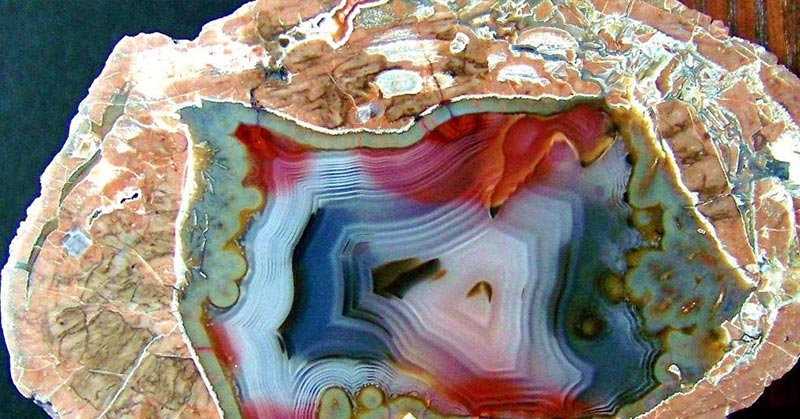Mother Nature is capable of some pretty incredible things. In some cases, where you least expect it, you find gorgeous, natural works of art. The Thunder Egg is one of those incredible geological phenomena.
The Thunderegg
Formed within rhyolitic volcanic ash layers, this is a rock similar to a geode with a gorgeous surprise inside. Spherical in shape, they are typically about the size of a baseball. The insides are made of chalcedony which has been fractured or broken. Deposits of agate, jasper, and opal then make their way into those crevices to create colorful and unique combinations. (1, 2)
On the outside, these rocks don’t look like much. Cut them in half and polish them up, however, and you may find yourself with an almost gem-stone like interior of patterns and colors. (1, 2)
Read: Ancient tree with record of Earth’s magnetic field reversal in its rings discovered
Is it a Geode or a Thunderegg?
Geode is simply a general term for a hollowed rock, often which has been filled with some sort of growth or crystal formation. There are many ways for hollows to form in rocks, meaning that there are many different types of geodes. Thundereggs are only formed by one specific situation, which is what primarily differentiates them from other geodes. A thunderegg is just one form that the agate can take. (1, 2)
Related: This NYC Museum has a 9,000-Pound Amethyst Geode, and it’s Breathtaking
How is a Thunder Egg Formed?
Thundereggs form in pockets of gas in rhyolite lava. This lava acts as a mold from the water that bubbles its way through the pores in the rock. The porous rock carries with it a solution of silica. As the bubbles cool, they are gradually filled with the silica (quartz)-containing water.
These deposits line and fill the hollow cavities first with a darker material and then with agate or chalcedony. The variation in color is due to the different mineral qualities of the soil that water filling these voids has passed through. (1, 2)
The veins of agate, chalcedony, and quartz are filled in later by hydrothermal fluids, which are a combination of groundwater and late-stage fluids that seep from the magma. These fluids then make their way through the fractures in the rocks. They then precipitate crystals along the walls of the cavity, which forms the geodes or geode-like centers. (1, 2)
The formation of a thunderegg usually requires several of these hydrothermal events. On close inspection, each will have clues as to its specific formation. (1, 2)
Where can you find Thundereggs?
Thundereggs are usually found embedded in the clay where they were formed. You can spot them because they are unusually round with a brownish-grey, bumpy exterior. (1, 2)
They are found in areas that have or once had volcanoes. Central and Eastern Oregon in the United States is one of the most common places to find thundereggs. Popular search spots include (1, 2):
- Alvord Desert
- White Rock Springs
- Whistler Springs
- Richardson Rock Ranch
- White Fir Springs
- Owyhee Reservoir
- Succor Creek Canyon
They can also be found in Washington, California, New Mexico, and places in Germany. (1, 2)
Wherever you find one and however it was formed, Thunder Eggs are a true testament to the wonders of the natural world.
Keep Reading: Opalized Petrified Wood

